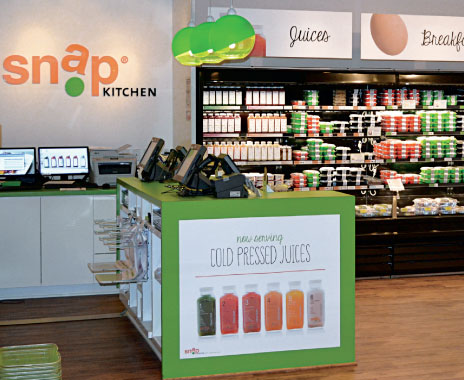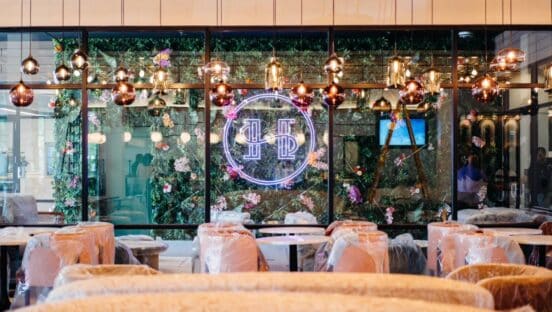Customers are increasingly on the go in today’s society, and quick-serve brands hoping to capitalize on their needs for more convenient food products are turning to pre-packaged, grab-and-go options.
“We are seeing an explosion of consumer interest in and usage of refrigerated, prepared meals at grocery retail, and [quick serves] are now picking up on this too,” says Laurie Demeritt, CEO of The Hartman Group, a Bellevue, Washington–based research and market strategy company. “Additionally, we are seeing an increase in immediate consumption occasions, and [quick serves] are already seen as a ‘go-to’ for these sorts of occasions.”
Items that qualify as grab-and-go are those that consumers are able to select from refrigerated or heated display areas while in line. Items are prepackaged, which is ideal for those in a hurry. Prominent brands like Starbucks and Pret A Manger have capitalized on the grab-and-go expansion opportunity.
Over the past few years, Starbucks has added an array of grab-and-go items to its menu. Among those are Bistro Boxes, La Boulange bakery items, and Evolution Harvest snacks.
“[We] are definitely seeing this food opportunity as a tremendous place for us to gain more share,” says Holly Hart Shafer, a spokeswoman for Starbucks. “We know our customers are looking to us as a place to get food along with their favorite Starbucks beverage, so we now offer a variety of grab-and-go items.”
Executives from Pret A Manger and Snap Kitchen, an upstart Texas-based brand, say the need for speed, accuracy, and efficiency in quick service has fueled the grab-and-go growth. To make this type of concept successful, they say, consumer convenience is key. They’ve also found that, after tackling those three components, their brands were able to provide customers a quick, easy experience.
“You can pull up at one of our stores, go grab food for yourself and your spouse or your kids for three days, and be in and out in four minutes flat,” says Martin Berson, CEO of Snap Kitchen. The healthy-food takeaway concept provides on-the-go meals for breakfast, lunch, and dinner, as well as snack and dessert items available for pick-up throughout the day.
Rob Naylor, president of London-based Pret A Manger—which has been making inroads into major U.S. markets, including New York and Chicago—says the convenience component of grab-and-go items is driving the trend.
“We wanted to have good, fresh, natural, tasty food, but served really fast, because city workers in London, at that time, would rush out of their office to grab a sandwich and rush back to their desk to continue to work,” he says. “We’re kind of a cross between a good restaurant, an Italian coffee bar, and, we like to say, a bullet train, because we’re extremely fast.”
The Hartman Group’s Demeritt says the fresh and healthy components of these grab-and-go items are also drawing consumers to the concept. “It is a reflection of a larger cultural change where consumers see refrigerated items as a fresher, healthier alternative to frozen food, shelf-stable food, and even typical fast food,” she says.
Berson says the emphasis on obesity issues, various diseases, and rising healthcare costs have driven consumers to embrace healthier habits. He says grab-and-go gained popularity because it encompasses many concerns within the healthy eating movement such as portion control, better ingredients, lower calories, and better handling of food allergens.
At Starbucks, bistro boxes rank as the most popular grab-and-go item, Shafer says, because of their nutritional content and freshness.
“We’ve seen this natural trend of positive coverage on the protein plate in general because it’s nutritious, wholesome, and fixes that afternoon need,” she says. “They are very nutritious with real ingredients that get you through the day.”
In addition to providing speed and nutrition, grab-and-go concepts face another obstacle: consistently maintaining freshness. Pret A Manger’s Naylor says that challenge is complicated by the number of units his brand operates. “We make thousands and thousands of sandwiches every day,” he says. “Making a sandwich is relatively simple, but to repeat that in many locations, many times a day, with many different people making those products is actually quite difficult.”
Berson also says maintaining freshness can be tricky. He researched and experimented with various recipes before considering a business plan for Snap Kitchen and admits originally doubting the concept’s viability.
“Everything we do has to be great, whether it’s consumed right out of the oven or off the stove top or eaten three days later after being in a refrigerator,” Berson says. “We really feel like we’ve done a fantastic job of vetting different food items and figuring out what works and what doesn’t.”
Naylor and Berson believe brands that maintain food quality and freshness; provide a fast, convenient experience; and offer wholesome to-go items have a substantial chance of success in the realm of grab-and-go concepts.







